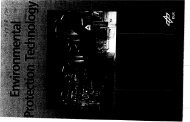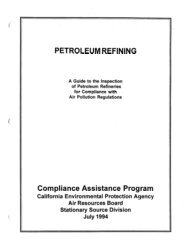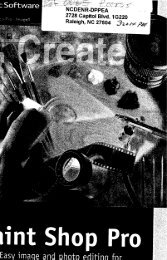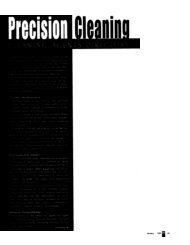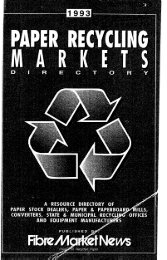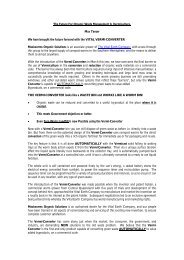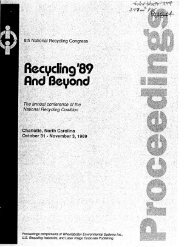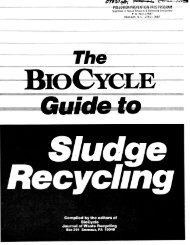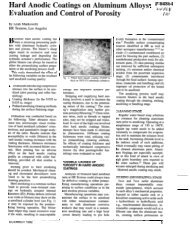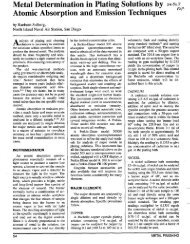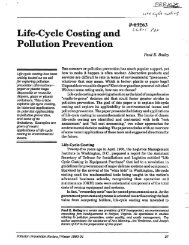Electronic Parts/Guidelines - infoHouse
Electronic Parts/Guidelines - infoHouse
Electronic Parts/Guidelines - infoHouse
You also want an ePaper? Increase the reach of your titles
YUMPU automatically turns print PDFs into web optimized ePapers that Google loves.
simple, to facilitate easy and fast replacement and procurement. For example, complex designs,<br />
sophisticated materials, and special tooling may cause high replacement cost and long replace-<br />
ment times.<br />
- Cleaning: For reusable items that need to be cleaned, be sure to include adequate liquid flow and<br />
drain holes. Or include materials that do not require special solvents needed for. cleaning or<br />
removing labels and markings.<br />
Disposal: Consider end-of-life disposal. When the container can no longer be used, can its mate-<br />
rials be recycled for other uses, or will the container material and design dictate landfill or<br />
incineration only? Select materials that can be easily recycled and design packages to make recy-<br />
cling easy (e& all one material or several materials that are easy to separate and sort). Quite<br />
oflen, the container or package manufacturer can suggest alternatives to make your container or<br />
material recyclable.<br />
Other Uses: When possible, design containers and packaging to be used for other programs (both<br />
current and future). With slight design changes. a reusable item designed and cost justified for one<br />
program may be applied to other programs that may not be able to justify unique rsusable con-<br />
tainer or packaging designs. Also, very durable designs, with minor modifications, may be cost<br />
effectively applied to future programs, thus extending a reusable item's reuse life beyond the life of<br />
one program.<br />
Shipping: Consider shipping weight and size to minimize shipping costs. These should be consid-<br />
ered for both full and empty containers or outgoing and returning reusable packaging materials. In<br />
addition to size and weight, the container style may affect shipping costs. For return shipping. it<br />
may be possible to design reusable containers to nest together or collapse when empty. However,<br />
these features often add more cost and are sometimes less conducive to automation.<br />
Protection and Handling: Be sure reusable packaging provides the same level of protection (e&,<br />
shock, vibration, abrasion, ESD. humidity, etc.) as the disposable packaging. In addition, be sure<br />
the reusable containers can be handled as easily as a disposable containers; avoid the need for<br />
additional handling labor or additional handling devices. This should be considered for all phases<br />
of container handling (e.g., packing, storing, shipping, unpacking, return shipping).<br />
Material Selectlon: The following is an overview of some materials typically used for reusable pack-<br />
aging and containers. Also included is an overview of some manufacturing techniques used to manu-<br />
facture reusable containers. The materials and manufacturing techniques includsd are not<br />
all-inclusive. Those materials included are only some of the more commonly used and in most cases,<br />
the most commonly recycled materials.<br />
High Density Polyethylene: Some of the most widely used reusable container materials are high<br />
density polyethylenes (PE-HD). PE-HD's offer good to excellent stiffness thru an excellent temperature<br />
range (-40 degrees F to +I50 degrees F). PE-HD is also a commodity material readily available and<br />
easily recycled.<br />
High Impact Polypropylene: This material is more durable than polyethylene, but not as stiff. Nor does<br />
it have the low temperature range usefulness that polyethylene has; it has a tendency to crack at<br />
impacts below 0 degrees F. Although recyclable, polypropylene recycling is not as widespread as<br />
.HDPE and some other materials.<br />
High Impact Polystyrene: High impact poylstyrene is another extremely stiff material that has excellent<br />
compressive load strength and good temperature range usefulness. However, polystyrene is more<br />
brittle than polyethylene and polypropylene and has a tendency to crack under high impact. It is also<br />
readily attacked by solvents. Polystyrene is used most often for shelf storage boxes, container inserts,<br />
and trays, rather than for shipping containers. It also holds it original shape after molding better than<br />
polyethylene and polypropylene. Polystyrene is easily recycled.



